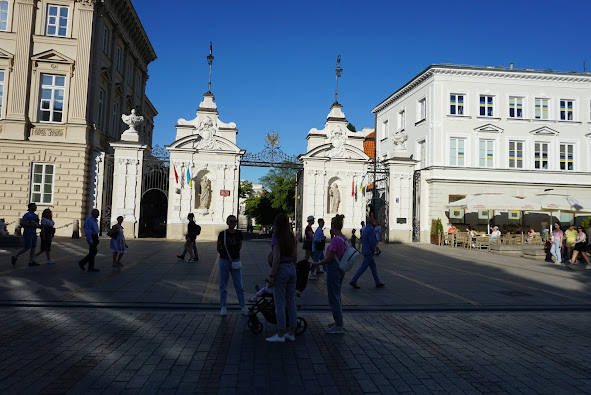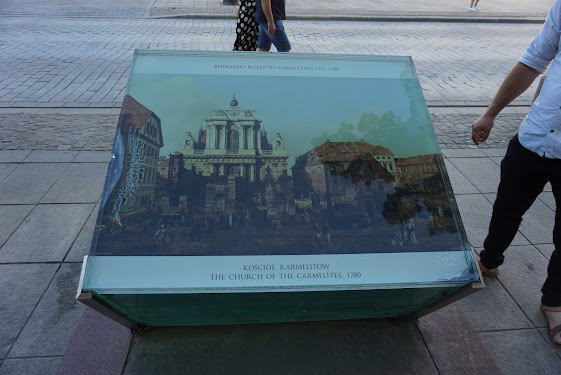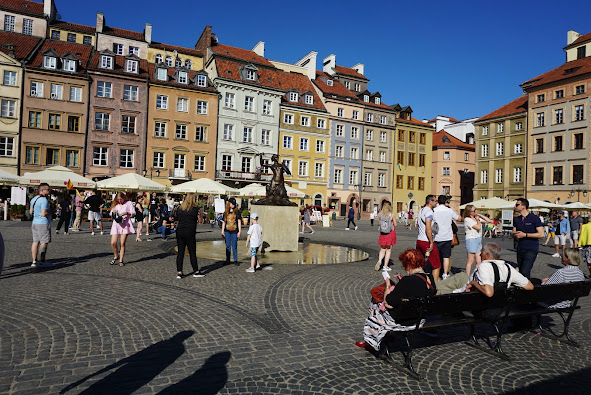Metro Nowy Świat Uniwersytet
Old Town Warsaw
#Warsaw tour guide #Warsaw city guide # guided tour in warsaw #Warszawa tour guide #Warszawa city guide #guided tour in Warszawa
A thorough exploration of the area around Old Town Warsaw is probably the most time-consuming trip among the metro stations. Here we land directly in the historic center, in other Words in the Old Town in Warsaw.

Ministry of Finance
When you ascend to ground level from Metro Nowy Świat Uniwersytet, one of the first things you see is the Ministry of Finance. Read more under “Communism in Warsaw”.
Short trips in Old Town Warsaw:
From Nowy Świat towards Krakowskie Przedmieście and Castle Square.

Academy of Science and Thorvaldsen’s Copernicus statue
After a short walk towards the centre through Nowy Świat street, we come to a small square that houses the Polish Academy of Science (PAN). In front of this Renaissance building stands Thorvaldsen’s statue of the medieval astronomer Copernicus (erected in 1830), who came from Torun, which was under Polish rule during Copernicus’ lifetime. Copernicus is presented as an ancient scientist, and the PAN building and Copernicus somehow elevate each other to a higher level. If you walk around the square and look down on the pavement, you’ll find some of the planets Copernicus studied throughout his life. If you feel like teasing the locals, you can claim that Copernicus was German, but be careful not to do so if you meet a nationalistic Polish person.

Holy Cross Church
From the square you can also see the Church of the Holy Cross (Bazylika Świętego Krzyża), where Chopin’s heart is enshrined – Address Krakowskie Przedmieście 3. Read more under ”Churches and grave yards in Warsaw”.

Speaking of Chopin, the Chopin Museum (Muzeum Chopina) is a few minutes’ walk from the metro station. It’s an interactive museum filled with music and the story of Chopin’s life. It’s exciting to see for tone-deaf tourists, while it’s a must-see for music lovers who will be able to enjoy the museum in every detail.
Chopin is the epitome of Polish romantic tradition and an important piece of Poland’s self-understanding, so he is eagerly exported through monuments, stories, concerts and piano competitions. In this area of central Warsaw, where Chopin grew up, a Chopin bench has been set up at key locations where you can rest. You can also press a button on the bench and it will play romantic piano music.

Bench with Chopin music
Around the old town, Chopin concerts for travellers have become a hit (and probably a box office success for the organisers). I wouldn’t particularly recommend any of the competing companies, but you’re bound to come across them on your walk through Old Town – otherwise, type “Chopin concert old town” into Google.

Immediately after the Holy Cross Church, the Academy of Fine Arts is through a gate on the left side of the street, while the University’s main campus is through a gate on the right side.
The entrance to the university campus. Entry is free and unless you’re in a hurry, you shouldn’t miss out on a tour of the area – both for the atmosphere and the architecture. More under “Warsaw as a centre of the Polish state”.

One of Canaletto’s works in a glass case. Read more under “Art in Warsaw”.
On the way to the castle square, you’ll come across a series of glass cubes with images of nearby buildings. The paintings are reproductions of works by Canaletto from the 18th century (Bernardo Bellotto, called Canaletto, 1721-1780). This Venetian artist worked from 1767 for the Polish king, and has since been called the photographic apparatus of his time. The old buildings were destroyed during WWII. The reconstructions are largely based on Canaletto’s paintings, which you can convince yourself of by comparing the painting with the building opposite.

St Anna Church – Academic Church (Kościół św. Anny) – Address Krakowskie Przedmieście 68. A stone’s throw from the Castle Square. Read more under ”Churches and grave yards in Warsaw”.
Kamienica Prażmowskich. As one of the last buildings before the castle square, it is worth noting the rococo building at no. 87 (right next to the building with the escalators), whose facade survived World War 2. (even if it was destroyed inside).
Plac Piłsudski

More under “Warsaw as a centre of the Polish state”.
Just before the church, you can turn left and land on Warsaw’s ‘national’ square, the square that symbolises Poland. It is heavily laden with monuments and symbols, both existing and destroyed.

Saxon Garden (Ogród Saski). Located between Plac Piłsudski (10 minutes from Metro Nowy Świat – Uniwersytet) and Plac Bankowy (200 metres from Metro Świętokrzyska).
If you’re only on a short trip to Warsaw but want to get a feel for the city’s parks, this is the place to visit as part of a walk through the historic centre. Read more under “Parks and forests in Warsaw”.


Presidential Palace with the equestrian statue of Poniatowski
The main building with the centre section is slightly recessed and is complemented by two low side buildings. There is also a small chancellery on the side facing the Castle Square. From the back side – garden and river views. More under “Warsaw as a centre of the Polish state”. From the back is a garden and river view. Read more under ‘Warsaw as the centre of the Polish state’.
Modelled by Bertel Thorvaldsen 1826-1827. The original plaster statue is in the archives of the Thorvaldsen Museum. Cast in bronze. General, freedom hero and nobleman. Relative of the king. Fought in Napoleon’s army but died in the Battle of Leipzig in 1813. Inspired by the Marcus Aurelius statue on the Capitol in Rome. When the statue was delivered, the Russians had just crushed an uprising in Poland and a crackdown on Polish symbols was underway, so the statue didn’t make it to Warsaw. Set up in Warsaw in 1923 (after independence). Blown up in 1944 as part of Nazi revenge for the Warsaw Uprising. In 1952, rebuilt according to the original model as a gift from the Danish state and Copenhagen.
Short trips:
By Nowy Świat towards Rondo de Gaulle.

The street Nowy Świat translates as “The New World”.
The section from Nowy Świat to Rondo de Gaulle was rebuilt later than the old town, and at that point it was felt that money could be spent on things other than reconstruction. The buildings on Nowy Świat were therefore slightly lower and built with less care than the first reconstructions. But the street is impressive nonetheless, and the side streets are filled with pubs and restaurants that are frequented by locals and tourists alike. If you’re into food, singing and beers and possibly a cocktail, it’s highly recommended to turn down Foksal Street, which offers quite a bit of that, while also giving you an artistic experience by looking at the renovated architecture (before you start the booze).

Nowy Świat ends in the mighty d’Gaulle Roundabout, which includes the Party House or the White House. The Square, the National Museum and the Polish Army Museum are featured under Metro Centrum.
Longer walks
Warsaws Old Town
The Old Town of Warsaw begins at the Castle Square and the Royal Palace. This was the original location of the old bridge into town, which has now been excavated and placed in the centre of the square. On one side, the city was protected by a partially rebuilt city wall, which in many places forms the gable wall of the buildings built against the wall. On the wall you can see a black stripe – the part below the stripe is the original city wall, the rest has been rebuilt. Below the city wall is a moat, but today it is without water.
At the separation between the Old Town (from 1300) and the New Town (from around 1400) is the Barbakan fortress, and down towards the river the city is protected by a steep cliff.
The Old Town was almost completely destroyed during WWII. After the war, it was painstakingly rebuilt, but – there was a lot more air. The squeezed city from before World War II could suddenly breathe.
However, the city is original if we look at essential elements: the streets run exactly as they did in the Middle Ages, the old town is where it has always been and the shape of the buildings is unchanged.
Crucial to Warsaw was the river and the escarpment, which provided drinking water, drainage and some protection from attack, allowing them to concentrate on defending the city from the other side – where we have the city walls.
Every visitor is taught that the Old Town in Warsaw is a faithful replica of the original pre-war Old Town, which is a truth with modifications. If you compare old photos, the facades of the Rynek and the neighbouring streets are relatively accurate to the original buildings, but everything inside the buildings has been completely changed.
The pre-war Old Town was a slum, often without plumbing and heating. The poorest people in the city lived here, and every square metre was utilised. After the war, comfortable apartments for the working population with modern facilities were built here according to the standards of the time.
The facades also became non-uniform because the destruction had revealed many of the old gates, walls and other elements that had been hidden by modernisation over time. In many cases, a patchwork quilt has been chosen that shows both the medieval elements of the buildings, but also the most recent pre-war elements.
Castle Square

The Castle Square with the Sigismund Column, the Royal Palace, the city walls and the beginning of the Old Town.
The Old Town starts with the Castle Square, where the column with King Sigismund from 1644 next to the Mermaid on the Rynek is a symbol of Warsaw. It was erected to tell the story of what a great king Sigismund was, and was part of the power struggle between the royal power and the high nobility.
In the 17th century, columns were usually reserved for Jesus, Mary and saints. In that way it also gives Sigismund a bit of saintliness. The Maria-column at St Anne’s Church a few hundred metres away was erected as a protest against the Sigismund column.
The Royal Castle (Zamek Królewski)
The square is dominated by the rebuilt Royal Palace from the early 1980s.
The Wasa King (the one on the pillar) expanded the castle 400 years ago and made it his headquarters. There is free access to the 5-edged enclosed courtyard, which is characterised by different styles depending on when they were erected or modernised.

The roof was first bombed in 1939 and later the building was blown up in 1944. The reconstruction was politically controversial and, after popular pressure, was only realised in the early 1980s. The Gothic brick wall refers to the oldest castle and is based on archaeological investigations of the castle from the 1920s. The coats of arms are those of Poland, Lithuania and the Habsburgs (from some Polish kings who were related to the Habsburgs). Den gotiske teglstensvæg refererer til det ældste slot, og er baseret på arkæologiske undersøgelser af slottet fra 1920’erne. Våbenskjoldene er Polens, Litauens og Habsburgs (fra nogle polske konger, som var i familie med Habsburgerne).

From the castle square, there is free and unrestricted access to the castle courtyard
Another wing plus the front wing is in early raw baroque (rust red), while the Saxon kings built a wing in rococo style towards the garden. The last wing was renovated by Poland’s last king, Poniatowski.

Here is a collection of Canaletto paintings from Warsaw in the late 18th century.
The castle is open to visitors. Here you can see the royal chambers, a number of representative halls and a significant collection of paintings, including Canaletto paintings from Warsaw and portraits of Polish kings and nobles.
The Castle Garden

The avenue just below the castle with views of the rest of the garden and the river
Below the castle you’ll find the newly built fairytale garden, along with the old royal library that survived the war. It is a baroque garden that has been restored to its (perhaps) original state with great attention to detail.

With views down to the river and Praga bank
The garden overlooks lower gardens and labyrinths, the riverbank and the other side of the Vistula including Praga. Upwards you can see the rococo façade of the palace.
Cathedral – Church of St John the Baptist in the Old Town (Bazylika archikatedralna św. Jana Chrzciciela) – Address: Świętojańska 8. The approach road from the castle square to Rynek in the Old Town.
The cathedral is one of Warsaw’s oldest churches. Over the centuries it has been remodelled and changed style several times, but with its proximity to the castle, it has always been crucial to the political development of the capital.

The cathedral is located on the narrow Świętojańska Street, which leads towards Rynek
The church includes a monument designed by Thorvaldsen and the original crypts are an exciting experience where you can meet deceased Polish kings and presidents. Behind the church is the town’s now defunct old cemetery, a cosy little square (Kanonia Street) with a church bell from 1646, and if you take a full circle around it while touching the bell and making a wish, it might come true. Read more under ”Churches and grave yards in Warsaw”. Bag kirken ligger byens nu ikke længere eksisterende gamle kirkegård, en hyggelig lille plads (Kanonia-gade) med en kirkeklokke fra 1646, og hvis man tager en hel runde om den, mens man rører ved klokken og ønsker et eller andet, kan det være, det går i opfyldelse. Mere under ”Kirker og kirkegårde i Warszawa”.
Rynek
In the old days, the town hall took up almost all of the large open space we see today. However, in 1795 Warsaw’s Old Town was merged with the New Town and a number of other districts, and the City Hall was not large enough to fulfil its function. The building was also in poor condition and was demolished in 1817.
The small houses on the roofs are today sometimes used as cosy rooms, but were originally intended to provide light for the stairwells, which were located inside the centre of the building.
Rynek is filled with symbols, including Warsaw’s guardian angel, the mermaid, which is a lot more warlike than the Danish version on Langelinie. The individual facades are colourful and tell the story of the square and the city.

The mermaid – who, according to one of several legends, is the sister of the cute little mermaid on Langelinie in Copenhagen. The guardian angel of Warsaw, with her sword raised, is far more warlike, so perhaps that’s why the two sisters preferred to live far apart.
The square is packed with restaurants and it’s generally not very expensive by Warsaw standards, especially compared to international tourist centres, but… the places are mainly based on tourists and you shouldn’t expect any special culinary experiences.
Warsaw City Museum

Models of some of the city’s most important buildings
At Rynek 28-42 you’ll find the Warsaw City Museum, which is only closed on Mondays. The museum has a nice overview with posters of the city’s development, models of the most important buildings and monuments, as well as a collection from archaeological excavations, which, as usual, reminds us that pottery is a very conservative industry where models remain unchanged over time.
The Dung Hill

River view from Warsaw’s old rubbish dump. Bring a padlock if you want to immortalise your love.
From Rynek, you can walk down Celna Street towards Dung Hill (Gnojna Góra), from where you can view the river. In the old days, the river ran close to the cliff, and this was where people emptied their rubbish and chamber pots in the good old days. From the small square in front of the cliff, there is a road that leads to the gardens under the Royal Palace.
Adjacent to the square – on ul. Brzozowa 11/13 – there is a small section of the Warsaw City Museum (Centrum Interpretacji Zabytku/ Centre for Interpretation of Cultural Monuments), which shows the concept behind the reconstruction of the old city. Here you can also see how severe the destruction was and compare it to what was later rebuilt. Closed on Mondays.
The New Town

Barbakan – the old defences (which can be viewed inside) mark the transition between Old Town and New Town.
Just beyond the old fortress – Barbakan – begins the New Town, which until 1791 was an independent municipality with its own quieter life than the capital. The reconstruction here is somewhat more modest than the Old Town, but the neighbourhood is definitely worth a visit and the stroll is less stressful and fast-paced than the walk through the Old Town.
Mariensztat
10 minutes from the Castle Square in the Old Town. Take the escalators.

Rynek in Mariensztat
From around 1550, a weakening of royal power in Poland began, with the regions and powerful nobles gaining more power. The weakening of central power was clearly seen in a swarm of mushrooming so-called “jurydiki”. These were independent, privately-owned small towns that surrounded Warsaw but were not subject to the laws and regulations of the city itself. They were usually owned by wealthy nobles, and since they weren’t bound by the city’s bureaucracy, they could sell manufactured goods cheaper than the city itself. The increase in the number of jurydiki really took off from around 1650, creating a vibrant competitive situation between the main city and the satellite towns. An example of such a satellite city is Mariensztat, located below the Castle Square in Warsaw. It was established quite late, in 1762, and sank into a poor neighbourhood that was severely damaged after the Warsaw Uprising in 1944. After the war, Mariensztat became the first rebuilt residential area to reflect the city’s former provincial character, while a social realist statue of a merchant woman symbolises the city’s past as a trading centre. If you’re in the castle square, it’s less than a ten-minute walk each way on the escalators, and it’s a refreshing trip if you want to get away from the Old Town itself.
The architecture of 1950s Poland was dictated by Stalin, who in architecture saw the realisation of his vision of society. In Poland, buildings were therefore constructed with a national form and socialist in content. It wasn’t necessarily all concrete palaces. A good example of the style can be seen in Mariensztat, which with its low houses and cosy town hall square is reminiscent of Polish Baroque.

Waweliowiec – The working class will live in imitated palaces
One of the most important buildings in Mariensztat is the “Waweliowiec” at 9 Bednarskiej Street, which with its colonnades is reminiscent of the medieval royal castle Wawel in Krakow. This is the essence of real socialism – a royal palace is converted into workers’ flats.
Please send an email to m@hardenfelt.pl if you would like an English-speaking tour guide to show you the most important places in Warsaw.
